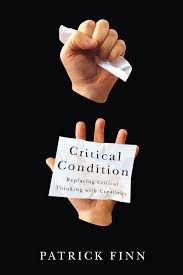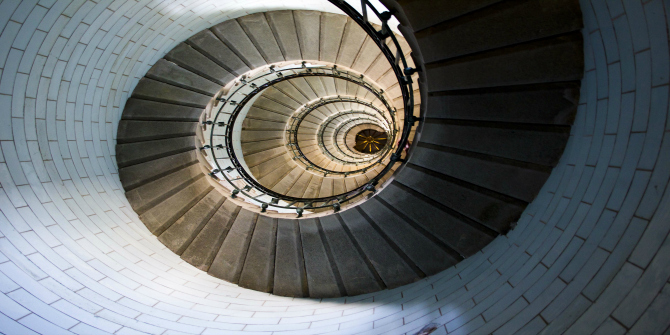In Critical Condition: Replacing Critical Thinking with Creativity, Patrick Finn expands upon his 2011 TEDx Talk, ‘Loving Communication’, to suggest that critical thinking implies disapproval and unnecessary judgement originating from a particular mode of Classical thought. Jodie Matthews argues that Finn’s discussion is dependent upon a crudely drawn straw man and neglects to consider thinking critically as a necessary corollary, rather than antithesis, to thinking creatively.
If you are interested in this review, you may also like to read Patrick Finn’s response, also published on LSE Review of Books.
Critical Condition: Replacing Critical Thinking with Creativity. Patrick Finn. Wilfrid Laurier University Press. 2015.
 It is impossible to argue with this book. This is not because Patrick Finn has produced something so well-executed that it should be taken as it stands; rather, it is impossible to argue with Critical Condition: Replacing Critical Thinking with Creativity’s central conceit or even its finer points because, on the book’s terms, that constitutes attack, violence. Finn suggests that creative minds welcome communication and attempt to respond in kind, a response that usually goes something like ‘yes, and…’. As a reader of Critical Condition, I simply cannot respond in the way this text demands. My response, which is still communication, which does not come from a mind lacking creativity, is ‘No. No, no, no.’
It is impossible to argue with this book. This is not because Patrick Finn has produced something so well-executed that it should be taken as it stands; rather, it is impossible to argue with Critical Condition: Replacing Critical Thinking with Creativity’s central conceit or even its finer points because, on the book’s terms, that constitutes attack, violence. Finn suggests that creative minds welcome communication and attempt to respond in kind, a response that usually goes something like ‘yes, and…’. As a reader of Critical Condition, I simply cannot respond in the way this text demands. My response, which is still communication, which does not come from a mind lacking creativity, is ‘No. No, no, no.’
Finn suggests that the definition of ‘critical’ as reasoned examination has ceded its proper place to definitions that imply disapproval and unnecessary judgement. The reason this shift has been so successful is, he thinks, because of critical thinking’s violent Classical origins. My own understanding of critical thinking in the twenty-first century (and the reader’s preconceptions about the idea are important to the way she approaches Finn’s work) is that it involves the intelligent, informed and self-aware exploration of a well-defined subject from a number of perspectives, building on the previous work of others to think about that subject in new ways.
Finn teaches and researches at the University of Calgary, and his work there provided material and impetus for an impassioned TEDx Talk in 2011. The gist of that talk is that ‘we have more to gain [in universities and, as a result, in wider society] from creative, contributory engagement than through the traditional attack and parry of critical thinking’ (2). Many people disagreed with Finn’s sentiments when the talk was posted on YouTube, and Critical Condition is a brief attempt to clarify his position.
 Image Credit: Davide Restivo
Image Credit: Davide Restivo
The critical thinking that Finn describes is not one that I recognise. On several occasions the descriptions sound more like individuals being very rude than a problem with their mode of thinking. Critical thinking (apparently) fosters suspicion and eschews hospitality. It is distinct from creativity. It is linear. It has ‘violence pump[ing] through [its] veins and arteries’ (4). Veins and arteries it may have, but this critical thinking is a straw man. Critical argument may, of course, ‘degrade into ad hominem or character attack’ (7), but that is not because of some quality inherent in critical thinking. Finn suggests that, in its reliance on critical thinking and thus on Socrates and Plato, our educational system harks back to ‘the imaginings of a heartbroken student trying to keep his teacher alive’. This argument – flippant as it might have been intended, it is hard to tell – collapses time, culture and understandings of subjectivity and thought.
I cannot decide if parts of the book are deliberately provocative, or if failing to apply critical thinking means that extreme suggestions are included because the ideas have not been properly sifted. A thorough examination of critical thinking should be critical thinking in action, but the thought experiment Finn invites fails because he is so keen to oppose the critical and the creative that the ideas do not make sense. He argues that ‘it is experts in critical thought who draw the writs that close theatres, censor books, and bring citizens before tribunals to answer for crimes related to the expression of ideas’ (32). I cannot manage a ‘yes, and…’, so a ‘maybe, but…’ will have to suffice: ‘maybe, but’ not all critical thinkers and not because of critical thought itself. Critical thinking cannot be implicated in simply maintaining the status quo or in disrupting it. Critical thinking is also what inspires the writing of the dangerous play, the unsettling book, the dissident ideas. The thought itself is lost to the mode of thinking in the picture that Finn paints. He suggests that critical thinking is to blame for all manner of horrors, including failing to prevent genocide in Rwanda. Perhaps he thinks that examples like this prove the importance of his subject matter and the very real connection between discursive violence and enacted violence. I would suggest that their glib inclusion without context or the working through of the idea is in poor taste, and that this is writing that performs its own kind of violence by throwing examples around uncritically and drawing equivalences that are senseless and damaging.
Finn’s concern for equipping students with the tools to succeed in a rapidly changing world is laudable. ‘Yes, and…’ is what we should all be doing in universities. My own response is that students need to be able to think critically and creatively to navigate the world Finn describes. The two are not mutually exclusive, and to ignore the necessity of thinking critically would be negligent towards those we teach.
Finn hopes for an ‘open, loving way of engaging with others that begins by extending the original speaker, writer, or communicator the benefit of the doubt’ (79). With a book this problematic, ‘loving’ is a very hard ask.
Jodie Matthews is a Lecturer in English Literature at the University of Huddersfield. Her research examines the representation of travelling communities in Britain in the nineteenth century, including Romani people and canal boat people. She has a background in Critical and Cultural Theory.
Note: This review gives the views of the author, and not the position of the LSE Review of Books blog, or of the London School of Economics.








3 Comments